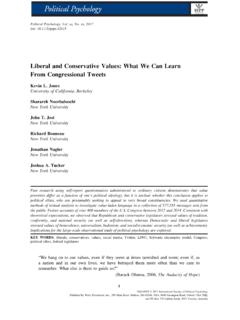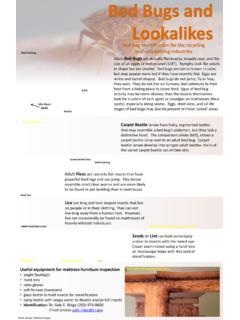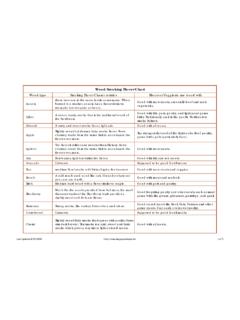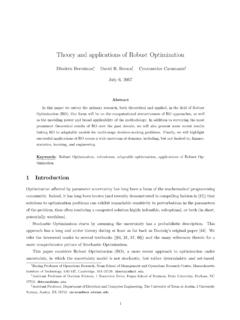Transcription of Three-Way ANOVA 22 - NYU Psychology
1 688 Chapter 22 Three-Way ANOVAACONCEPTUALFOUNDATION22 Chapter Three-Way ANOVAYou will need to use the following from previous chapters:Symbolsk:Number of independent groups in a one-way ANOVAc:Number of levels ( , conditions) of an RM factorn:Number of subjects in each cell of a factorial ANOVANT:Total number of observations in an experimentFormulasFormula : SSinter(by subtraction) also Formulas , , : SSbetor one of its componentsConceptsAdvantages and disadvantages of the RM ANOVASS components of the one-way RM ANOVASS components of the two-way ANOVAI nteraction of factors in a two-way ANOVASo far I have covered two types of two-way factorial ANOVAs: two-way inde-pendent (Chapter 14) and the mixed design ANOVA (Chapter 16). There is onlyone more simple two-way ANOVA to describe: the two-way repeated measuresdesign.
2 [There are other two-way designs, such as those including random-effects or nested factors, but they are not commonly used see Hays (1994) fora description of some of these.] Just as the one-way RM ANOVA can bedescribed in terms of a two-way independent-groups ANOVA , the two-way RMANOVA can be described in terms of a Three-Way independent-groups gives me a reason to describe the latter design next. Of course, the Three-Way factorial ANOVA is interesting in its own right, and its frequent use in thepsychological literature makes it an important topic to cover, anyway. I will dealwith the Three-Way independent-groups ANOVA and the two-way RM ANOVAin this section and the two types of Three-Way mixed designs in Section , the Three-Way ANOVA adds nothing new to the proce-dure you learned for the two-way; the same basic formulas are used a greaternumber of times to extract a greater number of SScomponents from SStotal(eight SSs for the Three-Way as compared with four for the two-way).
3 However,anytime you include three factors, you can have a Three-Way interaction, andthat is something that can get quite complicated, as you will see. To give you amanageable view of the complexities that may arise when dealing with threefactors, I ll start with a description of the simplest case: the 2 2 2 Simple Three-Way ExampleAt the end of Section B in Chapter 14, I reported the results of a publishedstudy, which was based on a 2 2 ANOVA . In that study one factor con-trasted subjects who had an alcohol-dependent parent with those who didnot. I ll call this the alcoholfactor and its two levels, at risk(of codepen-dency) and other factor (the experimenterfactor) also had twolevels; in one level subjects were told that the experimenter was an exploitiveperson, and in the other level the experimenter was described as a nurturingperson.
4 All of the subjects were women. If we imagine that the experimentwas replicated using equal-sized groups of men and women, the 8/23/02 11:56 M Page 688two-way design becomes a Three-Way design with gender as the third will assume that all eight cells of the 2 2 2 design contain the samenumber of subjects. As in the case of the two-way ANOVA , unbalanced Three-Way designs can be difficult to deal with both computationally and concep-tually and therefore will not be discussed in this chapter (see Chapter 18,section A). The cell means for a three -factor experiment are often displayedin published articles in the form of a table, such as Table A Conceptual Foundation689 NurturingExploitiveRow MeanControl:Men402834 Women302226 Mean352530At risk:Men364842 Women408864 Mean386853 Column three FactorsThe easiest way to see the effects of this experiment is to graph the cellmeans.
5 However, putting all of the cell means on a single graph would not bean easy way to look at the Three-Way interaction. It is better to use twographs side by side, as shown in Figure With a two-way design one hasto decide which factor is to be placed along the horizontal axis, leaving theother to be represented by different lines on the graph. With a three -waydesign one chooses both the factor to be placed along the horizontal axis andthe factor to be represented by different lines, leaving the third factor to berepresented by different graphs. These decisions result in six different waysthat the cell means of a Three-Way design can be us look again at Figure The graph for the women shows the two-way interaction you would expect from the study on which it is based.
6 Thegraph for the men shows the same kind of interaction, but to a considerablylesser extent (the lines for the men are closer to being parallel). This difference80706050403020 Nurturing0 ExploitiveControlAt riskWomenMen80706050403020 Nurturing0 ExploitiveControlAt riskGraph of Cell Means forData in Table 8/23/02 11:56 M Page 689in amount of two-way interaction for men and women constitutes a three -wayinteraction. If the two graphs had looked exactly the same, the Fratio for thethree-way interaction would have been zero. However, that is not a necessarycondition. A main effect of gender could raise the lines on one graph relativeto the other without contributing to a Three-Way interaction. Moreover, aninteraction of gender with the experimenter factor could rotate the lines onone graph relative to the other, again without contributing to the three -wayinteraction.
7 As long as the difference in slopes ( , the amount of two-wayinteraction) is the same in both graphs, the Three-Way interaction will be Interaction EffectsA Three-Way interaction can be defined in terms of simple effects in a way thatis analogous to the definition of a two-way interaction. A two-way interactionis a difference in the simple main effects of one of the variables as you changelevels of the other variable (if you look at just the graph of the women in Fig-ure , each line is a simple main effect). In Figure each of the twographs can be considered a simple effect of the Three-Way design more specif-ically, a simple interaction effect. Each graph depicts the two-way interactionof alcohol and experimenter at one level of the gender factor.
8 The three -wayinteraction can be defined as the difference between these two simple interac-tion effects. If the simple interaction effects differ significantly, the three -wayinteraction will be significant. Of course, it doesn t matter which of the threevariables is chosen as the one whose different levels are represented as differ-ent graphs if the Three-Way interaction is statistically significant, there will besignificant differences in the simple interaction effects in each of Three-Way InteractionsJust as there are many patterns of cell means that lead to two-way interac-tions ( , one line is flat while the other goes up or down, the two lines goin opposite directions, or the lines go in the same direction but with differ-ent slopes), there are even more distinct patterns in a Three-Way design.
9 Per-haps the simplest is when all of the means are about the same, except forone, which is distinctly different. For instance, in our present example theresults might have shown no effect for the men (all cell means about 40), nodifference for the control women (both means about 40), and a mean of 40for at-risk women exposed to the nice experimenter. Then, if the mean for at-risk women with the exploitive experimenter were well above 40, therewould be a strong Three-Way interaction. This is a situation in which all threevariables must be at the right level simultaneously to see the effect in thisvariation of our example the subject must be female andraised by an alco-hol-dependent parent andexposed to the exploitive experimenter to attain ahigh score.
10 Not only might the Three-Way interaction be significant, but onecell mean might be significantly different from all of the other cell means,making an even stronger case that all three variables must be combinedproperly to see any effect (if you were sure that this pattern were going tooccur, you could test a contrast comparing the average of seven cell meansto the one you expect to be different and not bother with the ANOVA at all).More often the results are not so clear-cut, but there is one cell meanthat is considerably higher than the others (as in Figure ). This kind ofpattern is analogous to the ordinal interaction in the two-way case and tendsto cause all of the effects to be significant. On the other hand, a three -wayinteraction could arise because the two-way interaction reverses its patternwhen changing levels of the third variable ( , imagine that in Figure 22 Three-Way 8/23/02 11:56 M Page 690the labels of the two lines were reversed for the graph of men but not for thewomen).







